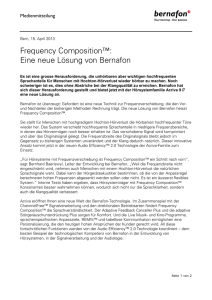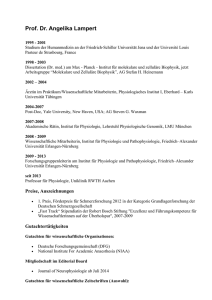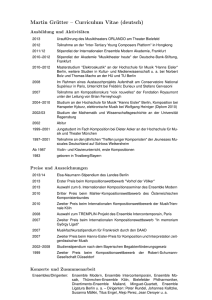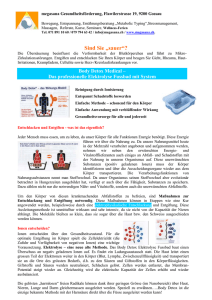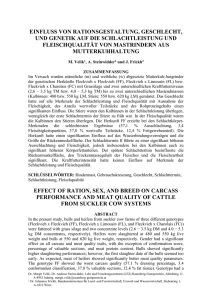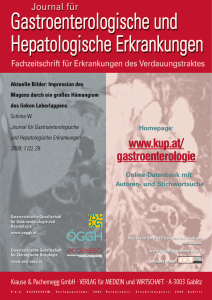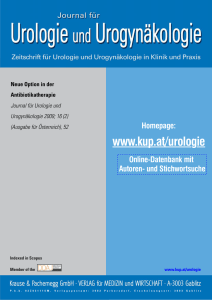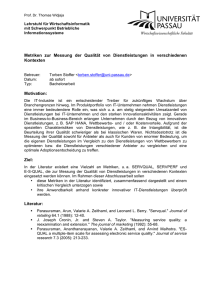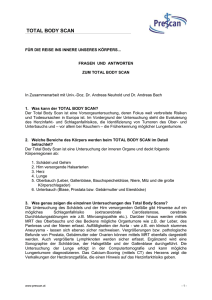Supplementary Material
Werbung
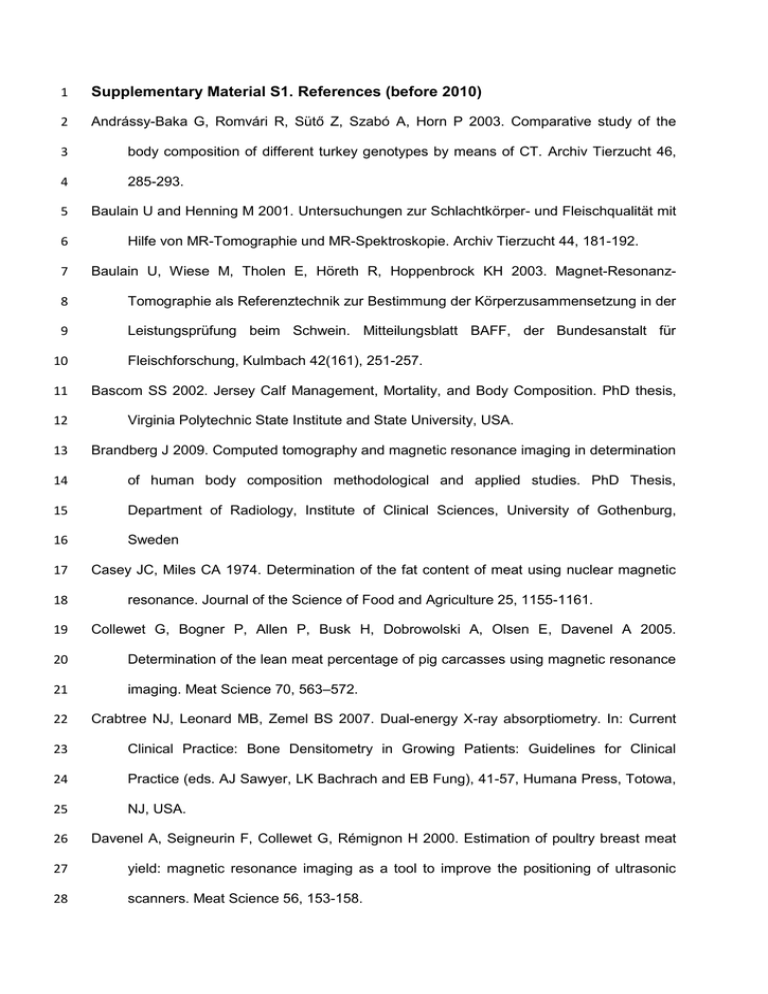
1 Supplementary Material S1. References (before 2010) 2 Andrássy-Baka G, Romvári R, Sütő Z, Szabó A, Horn P 2003. Comparative study of the 3 body composition of different turkey genotypes by means of CT. Archiv Tierzucht 46, 4 285-293. 5 Baulain U and Henning M 2001. Untersuchungen zur Schlachtkörper- und Fleischqualität mit 6 Hilfe von MR-Tomographie und MR-Spektroskopie. Archiv Tierzucht 44, 181-192. 7 Baulain U, Wiese M, Tholen E, Höreth R, Hoppenbrock KH 2003. Magnet-Resonanz- 8 Tomographie als Referenztechnik zur Bestimmung der Körperzusammensetzung in der 9 Leistungsprüfung beim Schwein. Mitteilungsblatt BAFF, der Bundesanstalt für 10 11 12 Fleischforschung, Kulmbach 42(161), 251-257. Bascom SS 2002. Jersey Calf Management, Mortality, and Body Composition. PhD thesis, Virginia Polytechnic State Institute and State University, USA. 13 Brandberg J 2009. Computed tomography and magnetic resonance imaging in determination 14 of human body composition methodological and applied studies. PhD Thesis, 15 Department of Radiology, Institute of Clinical Sciences, University of Gothenburg, 16 Sweden 17 18 Casey JC, Miles CA 1974. Determination of the fat content of meat using nuclear magnetic resonance. Journal of the Science of Food and Agriculture 25, 1155-1161. 19 Collewet G, Bogner P, Allen P, Busk H, Dobrowolski A, Olsen E, Davenel A 2005. 20 Determination of the lean meat percentage of pig carcasses using magnetic resonance 21 imaging. Meat Science 70, 563–572. 22 Crabtree NJ, Leonard MB, Zemel BS 2007. Dual-energy X-ray absorptiometry. In: Current 23 Clinical Practice: Bone Densitometry in Growing Patients: Guidelines for Clinical 24 Practice (eds. AJ Sawyer, LK Bachrach and EB Fung), 41-57, Humana Press, Totowa, 25 NJ, USA. 26 Davenel A, Seigneurin F, Collewet G, Rémignon H 2000. Estimation of poultry breast meat 27 yield: magnetic resonance imaging as a tool to improve the positioning of ultrasonic 28 scanners. Meat Science 56, 153-158. 29 Doeschl-Wilson AB, Green DM, Fisher AV, Carroll SM, Schofield CP, Whittemore CT 2005. 30 The relationship between body dimensions of living pigs and their carcass composition. 31 Meat Science 70, 229–240. 32 Drennan MJ, McGee M, Conroy SB, Keane MG, Kenny DA, Berry DP 2009. The relationship 33 between various live animal scores/measurements and carcass classification for 34 conformation and fatness with meat yield and distribution, and ultimate carcass value. 35 Beef Production Series No. 89, 1-40. 36 Dunshea FR, Suster D, Eason PJ, Warner RD, Hopkins DL, Ponnampalam EN 2007. Dual 37 energy X-ray absorptiometry (DXA) can be used to predict half-carcass composition in 38 lambs. Australian Journal of Experimental Agriculture 47, 1165--1171. 39 Fantazzini P, Gombia M, Schembri P, Simoncini N, Virgili R 2009. Use of magnetic 40 resonance imaging for monitoring Parma dry-cured ham processing. Meat Science 82, 41 219-227. 42 43 Font-i-Furnols M and Gispert M 2009. Comparison of different devices for predicting the lean meat percentage of pig carcasses. Meat Science 83, 443-446. 44 Giles LR, Eamens GJ, Arthur PF, Barchia IM, James KJ, Taylor RD 2009. Differential growth 45 and development of pigs as assessed by X-ray computed tomography. Journal of 46 Animal Science 87, 1648–1658. 47 48 Glasbey CA and Robinson CD 2002. Estimators of tissue proportions from X-ray CT images. Biometrics 58, 928-936. 49 Glasbey CA, Robinson CD, Young M 1999. Segmentation of X-ray CT images using 50 stochastic templates. Proceedings 10th International Conference on Image Analysis 51 and Processing, Venice, Italy, 746-751. 52 Gong QY, Phoenix J, Kemp GJ, García-Fiñana M, Frostick SP, Brodie DA, Edwards RH, 53 Whitehouse GH, Roberts N 2000. Estimation of body composition in muscular 54 dystrophy by MRI and stereology. Journal of Magnetic Resonance Imaging 12, 467- 55 475. 56 Groeneveld E, Kallweit E, Henning M and Pfau A 1983. Evaluation of body composition of 57 live animals by X-ray and NMR computed tomography. CEC Meeting: In Vivo 58 Measurement of Body Composition in Meat Animals. Bristol, UK, November 30 - 59 December 1, 84-89. 60 Hampe J, Nüske S, Scholz AM, Förster M 2005. Untersuchungen zur Körperzusam- 61 mensetzung und zum Wachstum von Kälbern unterschiedlicher genetischer Herkunft 62 mittels Dualenergie–Röntgenabsorptiometrie (DXA). Archiv Tierzucht 48, 428-444. 63 Hanna G and Cuschieri A 2001. Image display technology and image processing. World 64 65 66 67 68 Journal of Surgery 25, 1419–1427. Hogreve F 1938. Untersuchungen über die Fettbildung wachsender Mastschweine mittels der Röntgendurchleuchtung. Züchtungskunde 13, 178-191. Holló G, Szücz E, Tözsér J, Holló I, Seregi J, Repa I 2008. The use of X-ray computer tomography for slaughter value estimation of cattle. Archiva Zootechnica 11, 57-64. 69 Hopkins DL, Ponnampalam EN, Warner RD 2008. Predicting the composition of lamb 70 carcases using alternative fat and muscle depth measures. Meat Science 78, 400–405. 71 Hull H, He Q, Thornton J, Javed F, Wang J, Pierson RN, Gallagher D 2009. iDXA, Prodigy, 72 and DPXL dual-energy X-ray absorptiometry whole-body scans: a cross-calibration 73 study. Journal of Clinical Densitometry 12, 95–102. 74 Johansen J, Egelandsdal B, Røe M, Kvaal K, Aastveit AH 2007. Calibration models for lamb 75 carcass composition analysis using computerized tomography (CT) imaging. 76 Chemometrics and Intelligent Laboratory Systems 87, 303–311. 77 Johnson TRC 2009. Dual-energy CT – technical background. In: Multislice CT. 3rd Revised 78 Edition. (eds. MF Reiser, CR Becker, K Nikolaou, G Glazer), 65-73, Springer, 79 Germany. 80 Jones HE, Lewis RM, Young MJ, Simm G 2004. Genetic parameters for carcass composition 81 and muscularity in sheep measured by X-ray computer tomography, ultrasound and 82 dissection. Livestock Production Science 90, 167–179. 83 Jose CG, Pethick DW, Jacob RH, Gardner GE 2009. CT scanning carcases has no 84 detrimental effect on the colour stability of M. longissimus dorsi from beef and sheep. 85 Meat Science 81, 183-187. 86 Judas M, Höreth R, Dobrowolski A 2005. Computertomographie als Methode zur Analyse 87 der Schlachtkörper von Schweinen. Mitteilungsblatt Fleischforschung Kulmbach 44, 88 145-151. 89 Junkuszew A and Ringdorfer F 2005. Computer tomography and ultrasound measurement 90 as methods for the prediction of the body composition of lambs. Small Ruminant 91 Research 56, 121-125. 92 Kalender WA 1988. Densitometrie mit Zwei-Spektren-Verfahren in der 93 Computertomographie. In: Quo Vadis CT? (eds. C Claussen and R Felix), 312-324, 94 Springer, Germany. 95 96 97 98 Kalender WA 2006. X-ray computed tomography. Physics in Medicine and Biology 51, R29– R43. Kallweit E 1992. Measurement of body, carcass, and tissue composition in meat animals by non-invasive methods. Pig News and Information 13, 147N-148N. 99 Karamichou E, Richardson RI, Nute GR, McLean KA, Bishop SC 2006. Genetic analyses of 100 carcass composition, as assessed by X-ray computer tomography, and meat quality 101 traits in Scottish Blackface sheep. Animal Science 82, 151–162. 102 Kato H, Kuroda M, Yoshimura K, Yoshida A, Hanamoto K, Kawasaki S, Shibuya K, 103 Kanazawa S 2005. Composition of MRI phantom equivalent to human tissues. Medical 104 Physics 32, 3199 – 3208. 105 Kleczek K, Wawro K, Wilkiewicz-Wawro E, Makowski W, Konstantynowicz D 2009. 106 Relationships between breast muscle thickness measured by ultrasonography and 107 meatiness and fatness in broiler chickens. Archiv Tierzucht 52, 538-545. 108 109 Kolstad K. 2001. Fat deposition and distribution measured by computer tomography in three genetic groups of pigs. Livestock Production Science 67, 281–292. 110 Kolstad K, Mørkøre T, Thomassen MS 2008. Quantification of dry matter % and liquid 111 leakage in Atlantic cod (Gadus morhua) using computerised X-ray tomography (CT). 112 Aquaculture 275, 209-216. 113 Kongsro J, Røe M, Aastveit AH, Kvaal K, Egelandsdal B 2008. Virtual dissection of lamb 114 carcasses using computer tomography (CT) and its correlation to manual dissection. 115 Journal of Food Engineering 88, 86-93. 116 Kopp AF, Klingenbeck-Regn K, Heuschmid M, Küttner A, Ohnesorge B, Flohr T, Schaller S, 117 Claussen CD 2000. Multislice Computed Tomography: Basic Principles and Clinical 118 Applications. Electromedica 68, 94-105. 119 Kreuzer B 2008. Einfluss unterschiedlicher Energiegehalte in Alleinfuttermitteln der 120 ökologischen Putenmast auf den Wachstumsverlauf eines Putengenotyps, gemessen 121 mittels Dualenergie-Röntgenabsorptiometrie (DXA). PhD thesis, Veterinary Faculty, 122 Ludwig-Maximilians University Munich, Germany. 123 Kronacher C and Hogreve F 1936. Beiträge zur Kenntnis der Grundlagen der Beckenformen 124 bei verschiedenen Schweinerassen, gewonnen an Hand röntgenologischer Studien. 125 Zeitschrift für Züchtung. Reihe B, Tierzüchtung und Züchtungsbiologie einschließlich 126 Tierernährung 35, 161–167. 127 128 Kröger C, Bartle CM, West JG 2006. “Hybrid” calibrations of a dual energy X-ray scanner for material testing. Journal of Physics: Conference Series 41, 323–330. 129 Kullberg J, Angelhed JE, Lönn L, Brandberg J, Ahlström H, Frimmel H, Johansson L 2006. 130 Whole-body T1 mapping improves the definition of adipose tissue: consequences for 131 automated image analysis. Journal of Magnetic Resonance Imaging 24, 394–401. 132 Kullberg J, Ahlström H, Johansson L, Frimmel H 2007. Automated and reproducible 133 segmentation of visceral and subcutaneous adipose tissue from abdominal MRI. 134 International Journal of Obesity 31, 1806–1817. 135 136 Kvame T and Vangen O 2007. Selection for lean weight based on ultrasound and CT in a meat line of sheep. Livestock Science 106, 232-242. 137 Kvame T, Brenøe UT, Vangen O 2006. Body tissue development in lambs of two genetic 138 lines analysed by X-ray computer tomography. Small Ruminant Research 65, 242-250. 139 Lambe NR, Navajas EA, McLean KA, Simm G, Bünger L 2007. Changes in carcass traits 140 during growth in lambs of two contrasting breeds, measured using computer 141 tomography. Livestock Science 107, 37-52. 142 Lambe NR, Navajas EA, Schofield CP, Fisher AV, Simm G, Roehe R, Bünger L 2008. The 143 use of various live animal measurements to predict carcass and meat quality in two 144 divergent lamb breeds. Meat Science 80, 1138-1149. 145 146 Laurent W, Bonny JM, Renou JP 2000. Muscle characterisation by NMR imaging and spectroscopic techniques. Food Chemistry 69, 419-426. 147 Latorre MA, Pomar C, Faucitano L, Gariépy C, Méthot S 2008. The relationship within and 148 between production performance and meat quality characteristics in pigs from three 149 different genetic lines. Livestock Science 115, 258–267 150 Locsmandi L, Romvari R, Bogenfürst F, Szabo A, Molnar M, Andrassy-Baka G, Horn P 2005: 151 In vivo studies on goose liver development by means of computer tomography. Animal 152 Research 54, 135–145. 153 Macfarlane JM, Lewis RM, Emmans GC, Young MJ, Simm G 2009. Predicting tissue 154 distribution and partitioning in terminal sire sheep using x-ray computed tomography. 155 Journal of Animal Science 87, 107-118. 156 MacNeil MD and Northcutt SL 2008. National cattle evaluation system for combined analysis 157 of carcass characteristics and indicator traits recorded by using ultrasound in Angus 158 cattle. Journal of Animal Science 86, 2518-2524. 159 160 Mandarim-De-Lacerda CA 2003. Stereological tools in biomedical research. Anais da Academia Brasileira de Ciências 75, 469-486. 161 Marcoux M, Faucitano L, Pomar C 2005. The accuracy of predicting carcass composition of 162 three different pig genetic lines by dual-energy X-ray absorptiometry. Meat Science 70, 163 655–663. 164 Margeta V, Kralik G, Kušec G, Baulain U 2007. Lean and fat development in the whole body 165 and hams of hybrid pigs studied by magnetic resonance tomography. Czech Journal of 166 Animal Science 52, 130–137. 167 McEvoy FJ, Madsen MT, Strathe AB, Svalastoga E 2008. Hounsfield unit dynamics of 168 adipose tissue and non-adipose soft tissues in growing pigs. Research in Veterinary 169 Science 84, 300-304. 170 McEvoy FJ, Madsen MT, Nielsen MB, Svalastoga EL 2009. Computer tomographic 171 investigation of subcutaneous adipose tissue as an indicator of body composition. Acta 172 Veterinaria Scandinavica 51, 28. 173 Mercier J, Pomar C, Marcoux M, Goulet F, Thériault M, Castonguay FW 2006. The use of 174 dual energy X-ray absorptiometry to estimate the dissected composition of lamb 175 carcasses. Meat Science 73, 249-257. 176 Mitchell AD and Scholz AM 2009. Relationships among dual-energy X-ray absorptiometry 177 (DXA), bioelectrical impedance (BIA), and ultrasound measurements of body 178 composition of swine. Archiv Tierzucht 52, 28-39. 179 Mitchell AD, Conway JM, Scholz AM 1996. Incremental changes in total and regional body 180 composition of growing pigs measured by dual-energy-x-ray absorptiometry. Growth 181 Development and Aging 60, 113-123. 182 Mitchell AD, Scholz AM, Pursel VG 2000. Dual energy X-ray absorptiometry measurements 183 of the body composition of pigs of 90- to 130-kilograms body weight. Annals of the 184 New York Academy of Sciences 904, 85-93. 185 186 Mitchell AD, Scholz AM, Wang PC, Song H 2001. Body composition analysis of the pig by magnetic resonance imaging. Journal of Animal Science 79, 1800-1813. 187 Mitchell AD, Scholz AM, Pursel VG 2002. Prediction of the in vivo body composition of pigs 188 based on cross-sectional region analysis of dual energy X-ray absorptiometry (DXA) 189 scans. Archiv Tierzucht 45, 535-545. 190 Mitchell AD, Scholz AM, Pursel VG 2003. Prediction of pork carcass composition based on 191 cross-sectional region analysis of dual energy X-ray absorptiometry (DXA) scans. Meat 192 Science 63, 265-271. 193 Monziols M, Collewet G, Mariette F, Kouba M, Davenel A 2005. Muscle and fat quantification 194 in MRI gradient echo images using a partial volume detection method. Application to 195 the characterization of pig belly tissue. Magnetic Resonance Imaging 23, 745–755. 196 Monziols M, Collewet G, Bonneau M, Mariette F, Davenel A, Kouba M 2006. Quantification 197 of muscle, subcutaneous fat and intermuscular fat in pig carcasses and cuts by 198 magnetic resonance imaging. Meat Science 72, 146–154. 199 Müller S and Polten S 2004. Vergleichsuntersuchungen zur Ultraschall- 200 Speckdickenmessung beim Schwein im Rahmen der Eigenleistungsprüfung. Archiv 201 Tierzucht 47, 249-260. 202 Nanton DA, Vegusdal A, Bencze Rørå AM, Ruyter B, Baeverfjord G, Torstensen BE 2007. 203 Muscle lipid storage pattern, composition, and adipocyte distribution in different parts of 204 Atlantic salmon (Salmo salar) fed fish oil and vegetable oil. Aquaculture 265, 230-243. 205 Navajas EA, Lambe NR, McLean KA, Glasbey CA, Fisher AV, Charteris AJL, Bünger L, 206 Simm G 2007. Accuracy of in vivo muscularity indices measured by computed 207 tomography and their association with carcass quality in lambs. Meat Science 75, 533- 208 542. 209 Nissen PM, Busk H, Oksama M, Seynaeve M, Gispert M, Walstra P, Hansson I, Olsen E 210 2006. The estimated accuracy of the EU reference dissection method for pig carcass 211 classification. Meat Science 73, 22–28. 212 Pearce KL, Ferguson M, Gardner G, Smith N, Greef J, Pethick DW 2009. Dual X-ray 213 absorptiometry accurately predicts carcass composition from live sheep and chemical 214 composition of live and dead sheep. Meat Science 81, 285-293. 215 216 Plank LD 2005. Dual-energy X-ray absorptiometry and body composition. Current Opinion in Clinical Nutrition and Metabolic Care 8, 305–309. 217 Ponnampalam EN, Butler KL, Hopkins DL, Kerr MG, Dunshea FR, Warner RD 2008. 218 Genotype and age effects on sheep meat production. 5. Lean meat and fat content in 219 the carcasses of Australian sheep genotypes at 20-, 30- and 40-kg carcass weights. 220 Australian Journal of Experimental Agriculture 48, 893-897. 221 Romvári R, Szabó A, Karpati J, Kovach G, Bazar G, Horn P 2005. Measurement of belly 222 composition variability in pigs by in vivo computed tomographic scanning. Acta 223 Veterinaria Hungarica 53, 153–162. 224 Romvári R, Dobrowolski A, Repa I, Allen P, Olsen E, Szabó A, Horn P 2006. Development of 225 a computed tomographic calibration method for the determination of lean meat content 226 in pig carcasses. Acta Veterinaria Hungarica 54, 1-10. 227 228 Rosset A, Spadola L, Ratib O 2004. OsiriX: An Open-Source Software for Navigating in Multidimensional DICOM Images. Journal of Digital Imaging 17, 205-216. 229 Scholz AM and Förster M 2006. Genauigkeit der Dualenergie-Röntgenabsorptiometrie zur 230 Ermit-tlung der Körperzusammensetzung von Schweinen in vivo. Archiv Tierzucht 49, 231 462-476. 232 233 Scholz AM and Baulain U 2009. Methoden zur Bestimmung der Körperzusammensetzung am lebenden Nutztier. Züchtungskunde 81, 86-96. 234 Scholz A, Baulain U, Kallweit E 1993. Quantitative Analyse von Schnittbildern lebender 235 Schweine aus der Magnet-Resonanz-Tomographie. Züchtungskunde 65, 206-215. 236 Scholz A, Soffner P, Littmann E, Peschke W, Förster M 2002. Genauigkeit der Dualenergie- 237 Röntgenabsorptiometrie (DXA) zur Ermittlung der Schlachtkörperzusammensetzung von 238 Schweinehälften (kalt, 30-39 kg) anhand der EU-Referenzzerlegung. Züchtungskunde 74, 376- 239 391. 240 Scholz AM, Nüske S, Förster M 2003. Body composition and bone mineralization in calves of 241 different genetic origin by using dual energy X-ray absorptiometry. Acta Diabetologica 242 40 (Suppl.1), S91–S94. 243 Scholz AM, Mitchell AD, Förster M, Pursel VG 2007. Two-site evaluation of the relation 244 between in vivo and carcass dual energy x-ray absorptiometry (DXA) in pigs. Livestock 245 Science 110, 1–11. 246 Schöllhorn B and Scholz AM 2007. Untersuchungen zur Anwendbarkeit der Dualenergie- 247 Röntgenabsorptiometrie (DXA) für die Messung der Ganzkörperzusammensetzung bei 248 zwei Putengenotypen. Archiv für Geflügelkunde 71, 228–236. 249 250 Schreiweis MA, Orban JI, Ledur MC, Moody DE, Hester PY 2005. Validation of dual-energy X-ray absorptiometry in live White Leghorns. Poultry Science 84, 91–99. 251 Schröder UJ and Staufenbiel R 2006. Invited review: methods to determine body fat reserves 252 in the dairy cow with special regard to ultrasonographic measurement of backfat 253 thickness. Journal of Dairy Science 89, 1–14. 254 Skjervold H, Grønseth K, Vangen O, Evensen A 1981. In vivo estimation of body composition 255 by computerized tomography. Zeitschrift für Tierzüchtung und Züchtungsbiologie 98, 256 77-79. 257 Starck JM, Dietz MW and Piersma T 2001. The assessment of body composition and other 258 parameters by ultrasound scanning. In: Body Composition Analysis of Animals (ed. JR 259 Speakman), 188-210, Cambridge University Press, New York, USA 260 261 262 Stouffer JR 2004. History of ultrasound in animal science. Journal of Ultrasound in Medicine 23, 577–584. Suster D, Leury BJ, Hofmeyr CD, D’Souza DN, Dunshea FR 2004. The accuracy of dual 263 energy X-ray absorptiometry (DXA) weight, and P2 back fat to predict half-carcass and 264 primal-cut composition in pigs within and across research experiments. Australian 265 Journal of Agricultural Research 55, 973-982. 266 Suther S 2009. Genetics and marbling. ANGUS Journal September, 112-113. 267 Swennen Q, Janssens GPJ, Geers R, Decuypere E, Buyse J 2004. Validation of dual-energy 268 X-ray absorptiometry for determining in vivo body composition of chickens. Poultry 269 Science 83,1348–1357. 270 Szabó C and Babinszky L 2008. The effect of carcass temperature and treatment on the 271 computer tomography based tissue separation. Acta agriculturae Slovenica, S 2, 181– 272 185. 273 Szabó C and Babinszky L 2009. Minimum slicing interval and frequency for CT-based 274 prediction of pig’s body composition. Italian Journal of Animal Science 8 (Suppl. 3), 275 246-248. 276 Temple RS, Stonaker HH, Howry D, Posakony G, Hazaleus HM 1956. Ultrasonic and 277 conductivity methods for estimating fat thickness in live cattle. Proceedings Western 278 Sec-tion American Society of Animal Production, July 15-18, Reno, Nevada, USA, 7, 279 477–481. 280 Tholen E, Baulain U, Henning MD, Schellander K 2003. Comparison of different methods to 281 assess the composition of pig bellies in progeny testing. Journal of Animal Science 81, 282 1177-1184. 283 284 285 Thomas AMK, Banerjee AK, Busch U (eds.) 2005. Classic papers in modern diagnostic radiology. Springer-Verlag, Berlin Heidelberg, Germany. Török M, Polgar JP, Kocsi G, Farkas V, Szabo F 2009. Correlation of ultrasonic measured 286 ribeye area and fat thickness to the certain traits measured on slaughtered bulls. 287 Archiv Tierzucht 52, 23-27. 288 Ulzheimer S and Flohr T 2009. Multislice CT: Current technology and future developments. 289 In: Multislice CT, 3rd revised edition, (eds. MF Reiser, CR Becker, K Nikolaou and G 290 Glazer) Medical Radiology, 3-23, Springer, Berlin Heidelberg, Germany. 291 292 293 294 295 Vester-Christensen M, Erbou SGH, Hansen MF, Olsen EV, Christensen LB, Hviid M, Ersbøll BK, Larsen R 2009. Virtual dissection of pig carcasses. Meat Science 81, 699–704. Visscher PM, Hill WG, Wray NR 2008. Heritability in the genomics era - concepts and misconceptions. Nature Reviews Genetics 9, 255-266. Vogt FM, Ruehm S, Hunold P, de Greiff A, Nuefer M, Barkhausen J, Ladd SC 2007. Schnelle 296 Ganzkörperfettmessung mittels MRT: Quantifizierung und Topografie. Fortschritte auf 297 dem Gebiet der Röntgenstrahlen und der bildgebenden Verfahren 179, 480–486. 298 299 300 Vogt C, Laihem K, Wiebusch C 2008. Speed of sound in bubble-free ice. The Journal of the Acoustical Society of America 124, 6 pgs. von Korn S, Baulain U, Arnold M, Brade W 2005. Nutzung von Magnet-Resonanz- 301 Tomographie und Ultraschalltechnik zur Bestimmung des Schlachtkörperwertes beim 302 Schaf. Züchtungskunde 77, 382 – 393. 303 Wolf BT and Jones DA 2007. Inheritance of an in vivo leg conformation score in Texel lambs 304 and its association with growth, ultrasonic measurements and muscularity. Livestock 305 Science 110, 133–140. 306 Wood SE 2004. The effectiveness of dual energy X-ray absorptiometry to non-invasively 307 determine body composition of hybrid striped bass. Master Thesis, University of 308 Maryland, College Park, MD, USA. 309 310 311 312 Young MJ, Simm G, Glasbey CA 2001. Computerised tomography for carcass analysis. Proceedings of the British Society of Animal Science, 250-254. Youssao IAK, Verleyen V, Leroy PL 2002. Prediction of carcass lean content by real-time ultrasound in Pietrain and negative stress Pietrain. Animal Science 75, 25-32.
